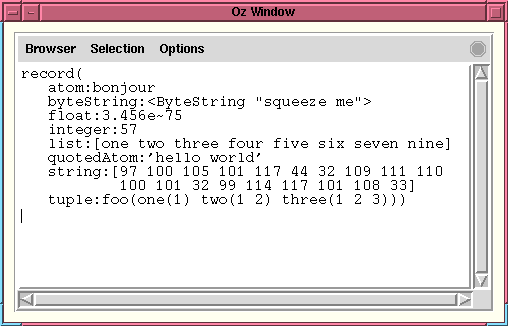4 Using Browser Objects
All Browsers in the Oz system are Oz objects. The BrowserClass is the class definition of these objects. In this section the usage of these objects is described.
4.1 Creating A Browser Object
One can create Browser objects similarly to the pre-defined Browser one:
BrowserObject = {New Browser.'class' init}The plain init method makes a newly created Browser placed on its own toplevel widget. One can tell a Browser object to use a Tk frame (see for details) as its toplevel frame:
declare W F BrowserObject in
%%
W = {New Tk.toplevel tkInit(bg:ivory)}
{Tk.send wm(geometry W "500x300")}
%%
F = {New Tk.frame tkInit(parent : W
bd : 3
bg : white
relief : groove
width : 450
height : 250)}
{Tk.send pack(F fill:both padx:10 pady:10 expand:true)}
%%
BrowserObject = {New Browser.'class' init(origWindow: F)}
{BrowserObject createWindow}
%%
{BrowserObject
browse(
record(
atom: bonjour
quotedAtom: 'hello world'
list: [one two three four five six seven nine]
integer: 57
float: 34.56e~76
string:"adieu, monde cruel!"
byteString:{ByteString.make "squeeze me"}
tuple: foo(one(1) two(1 2) three(1 2 3))))}The window produced that way is shown on Figure 4.1. Such a browser is called an embedded Browser, compared to a stand-alone Browser using its own toplevel widget.
Note that when a Browser object is created, either stand-alone or embedded, its window does not appear immediately. This happens when either createWindow or browse methods are applied.
A Browser window can be closed by means of the closeWindow method. Each time a Browser window is closed its buffer is flushed. A Browser object itself can be closed by means of the close method, which deletes its window and frees used by the object memory. A subsequent application of a Browser object closed this way proceeds as it were just created\footnote{This feature is used in the pre-defined Browser, which can be closed many times but never dies. Note that this behavior is not ``re-creating'' since no new Browser object is created immediately.}.
Note that the closeWindow method has no effect for embedded application browsers.
An embedded browser and its frame should be closed by sending the close messages on the Browser object and on the frame object in that sequence. For instance, in our example it would be
{BO close}
{F close}4.2 Browser Object Methods
Browser objects are controlled by user through the Browser GUI, and by means of application of them to the BrowserClass methods. At the glance, there are the following public methods of a Browser object, where X and Y are certain internal default values:
meth init(origWindow: OrigWindow <= X)
meth createWindow
meth closeWindow
meth close
meth browse(Term)
meth break
meth clear
meth clearAllButLast
meth rebrowse
meth option(...)
meth add(Action label:Label <= Y)
meth set(Action)
meth delete(Action)
meth refineLayout